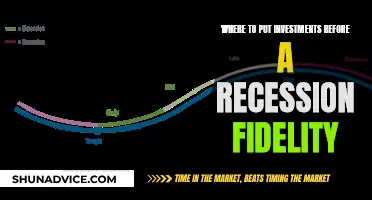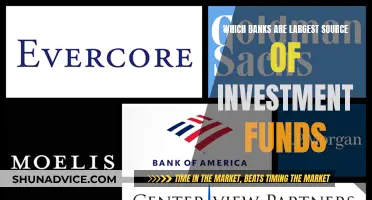
Exchange-traded funds (ETFs) are a popular investment choice for retirement planning. They are investment vehicles that combine the features of stocks and mutual funds, providing a simple and flexible way to gain exposure to a wide range of assets. ETFs are traded on stock exchanges, allowing investors to buy and sell them throughout the day, and they typically have lower expense ratios than mutual funds. This makes them attractive for investors seeking to keep costs low and wanting to access their investments easily.
ETFs offer benefits such as income generation, long-term growth potential, simplicity, diversification, low expenses, and tax efficiency, making them a sound investment option for retirees. However, it's important to consider both the advantages and disadvantages before investing. While ETFs provide a diversified portfolio, they are not risk-free, and there may be times when they produce negative returns.
Ultimately, the decision to invest in ETFs for a retirement fund depends on an individual's financial goals, risk tolerance, and investment strategy.
| Characteristics | Values |
|---|---|
| Advantages | Low expense ratios, intraday trading, diversification, low cost, tax efficiency, simplicity, income generation, long-term growth potential |
| Disadvantages | May encourage excessive trading behaviour, Complexities in record-keeping, Intraday trading could lead to different end-of-day values |
| Comparison to Mutual Funds | Traded on stock exchanges throughout the day, lower expense ratios, more tax-efficient, no minimum investment requirements, passively managed, lower commissions, no sales charges |
| Best Types of ETFs for Retirement | Dividend ETFs, Fixed-Income ETFs, Real Estate ETFs, Total Market ETFs, Sector ETFs |
What You'll Learn

ETFs vs Mutual Funds for retirement
When it comes to retirement planning, there are several options to consider, such as exchange-traded funds (ETFs) and mutual funds. Both have their advantages and disadvantages, and understanding the differences between the two can help individuals make informed decisions about their investment strategies.
Similarities Between ETFs and Mutual Funds:
ETFs and mutual funds share some similarities. Both are professionally managed collections or "baskets" of individual stocks or bonds, offering built-in diversification and reduced risk compared to investing in individual stocks and bonds. They provide investors with access to a wide range of investment options, including U.S. and international stocks and bonds, allowing for broad or narrow investment strategies. Additionally, both types of funds are overseen by professional portfolio managers who make investment decisions on behalf of the investors.
Key Differences Between ETFs and Mutual Funds:
Despite their similarities, there are several key differences between ETFs and mutual funds that individuals should consider when planning for retirement.
Investment Minimums:
ETFs typically have lower investment minimums, allowing investors to purchase a single share at the market price, which could be as low as $50 or a few hundred dollars. In contrast, mutual funds often have higher minimum initial investments, which are set as a flat dollar amount and may not be affordable for investors with limited capital.
Control Over Trade Price:
ETFs provide investors with more hands-on control over the price of their trades. They offer real-time pricing and allow for the use of sophisticated order types, giving investors greater control over their investment decisions. Mutual funds, on the other hand, provide a simpler approach, offering a single price at the end of the trading day for all investors who bought or sold that day.
Active vs. Passive Management:
Most ETFs are passively managed, meaning they track a specific index or benchmark. In contrast, mutual funds can be actively managed, with fund managers making investment decisions to try to outperform the market. Actively managed funds tend to have higher fees due to the increased research and management involved.
Expense Ratios:
ETFs generally have lower expense ratios than mutual funds, especially when passively managed. This is because they require less administrative work and have lower operating costs. Mutual funds, particularly actively managed ones, often have higher expense ratios, which can impact long-term returns.
Tax Efficiency:
ETFs are often considered more tax-efficient than mutual funds. Their structure minimizes capital gains distributions to investors, reducing the tax liability for retirees. Mutual funds, on the other hand, can generate capital gains within the portfolio, which may result in taxable events for investors.
Automatic Investments and Withdrawals:
Mutual funds offer the convenience of setting up automatic investments and withdrawals based on an individual's preferences. ETFs, on the other hand, do not typically allow for automatic transactions and require manual intervention for each trade.
Both ETFs and mutual funds have their advantages and can be used as part of a comprehensive retirement plan. ETFs offer lower investment minimums, greater control over trade prices, lower expense ratios, and tax efficiency. Mutual funds provide the convenience of automatic transactions and the potential for active fund management, albeit with potentially higher fees. Ultimately, the decision to invest in ETFs, mutual funds, or a combination of both depends on an individual's financial goals, risk tolerance, and investment strategy.
Understanding Ultra Short-Term Funds: A Smart Investment Strategy
You may want to see also

Pros and Cons of ETFs for retirement
Pros
ETFs, or Exchange-Traded Funds, are a popular investment choice for retirees thanks to their many benefits. Here are some of the advantages of investing in ETFs for retirement:
- Income generation: ETFs can provide supplemental income in retirement, as they pay dividends like stocks and interest like bonds.
- Long-term growth potential: With many retirees living for 20 years or more after retirement, ETFs offer the potential for long-term growth, often outperforming actively managed portfolios with similar investment strategies.
- Simplicity: ETFs are generally easier to build into a portfolio than individual stocks and bonds, and retirees can accomplish their investment goals with a relatively small set of ETFs.
- Diversification: ETFs provide exposure to hundreds of stocks or other assets in one packaged security, offering more stable returns than individual stocks.
- Low expenses: ETFs have much lower expense ratios than mutual funds, and these lower expenses can lead to higher returns over time.
- Tax efficiency: The structure of ETFs makes them more tax-efficient than other investment options, minimising capital gains taxes for retired investors with taxable accounts.
- Low cost: ETFs are often cheaper to own and trade than other funds, making them more liquid.
- Flexibility: ETFs are traded on stock exchanges throughout the day, providing intraday trading flexibility.
Cons
Despite their many advantages, there are also some potential drawbacks to consider when investing in ETFs for retirement:
- Risk: ETFs are not risk-free, and even a diversified ETF portfolio can produce negative returns, as seen during the inflationary period of 2022-23.
- Lack of control: Investors in individual securities can choose which stocks and bonds to hold, whereas ETF investors cannot select the specific stocks or bonds held within the fund.
- Intraday trading: The ability to trade ETFs during the day may not appeal to employers who want their employees focused on work, and retirement plans are meant for long-term investments rather than intraday trading.
- Tax considerations: The tax benefits of ETFs are less relevant in a tax-deferred retirement plan like a 401(k).
- Complexity: ETFs can introduce complexities in record-keeping and may require different operational processes within 401(k) plans.
What Makes Hedge Funds Managed Investment Companies?
You may want to see also

Types of ETFs for retirement
Exchange-traded funds (ETFs) are a popular investment choice for many investors due to their benefits and low costs. They are also part of some retirement plans, allowing retirement planners to diversify their holdings.
There are two main types of ETFs: passively managed and actively managed funds. Most ETFs are passively managed, meaning they track an index or benchmark to keep costs to a minimum. Actively managed funds, on the other hand, are benchmarked against an index but do not track it directly.
Bond ETFs
These track government (federal, municipal, local) and corporate bonds. They are also known as fixed-income ETFs.
Commodity ETFs
These track various commodities like oil, grains, and precious metals, which are sold through futures contracts.
Currency ETFs
These track one or a basket of currencies.
Cryptocurrency ETFs
A newer type of ETF that tracks the performance of virtual or digital currencies like Bitcoin and Ethereum.
Equity ETFs
These track different types of equity classes, such as large caps and blue chips.
Index ETFs
These track market indexes, such as the S&P 500 and Dow Jones Industrial Average (DJIA).
Sector ETFs
These ETFs track the index of a specific market sector, such as technology, healthcare, real estate, utilities, energy, or financials.
Total Market ETFs
These track the performance of a broad market index, capturing large segments of the stock or bond market.
A Smart Guide to Investing in Dow Jones Index Funds
You may want to see also

How to choose between actively and passively managed funds
When deciding between actively and passively managed funds, there are several factors to consider. Both have their advantages and disadvantages, and the best choice depends on your financial goals, risk tolerance, and investment style. Here are some key points to help you choose between the two:
Actively Managed Funds:
- Active management involves a more hands-on approach, with fund managers making buying and selling decisions based on their expectations of the securities' performance.
- Active management can be beneficial for investors who believe in the expertise of fund managers and their ability to beat the market.
- Active funds offer more flexibility as managers are not required to hold specific stocks or bonds.
- They also provide opportunities for hedging and risk management, allowing investors to insure against losses and exit specific holdings when risks become too high.
- Active funds usually come with higher fees to cover the costs of research, analysis, and portfolio management.
- Active funds may be more suitable for certain niche markets, such as emerging markets and small-company stocks, where less liquidity and lower visibility provide opportunities for active managers.
Passively Managed Funds:
- Passive management, on the other hand, aims to mirror the performance of a specific index by holding the same or similar securities in similar proportions.
- Passive funds, also known as index funds, offer very low fees since there is no need to actively analyse securities.
- They provide good transparency as investors always know what stocks or bonds are included in the fund.
- Passive funds are tax-efficient due to their buy-and-hold strategy, which minimises annual capital gains tax.
- Passive management is a straightforward approach that appeals to investors who want to duplicate market returns instead of trying to beat them.
- Passive funds may be less suitable for high-net-worth investors who have access to elite advisers and are willing to pay higher fees for potentially better returns.
The choice between active and passive management depends on your investment goals and style. Active management may suit investors who want more flexibility and are willing to take on more risk to beat the market. On the other hand, passive management is a simpler, low-cost strategy that aims to mirror market returns and is often favoured by investors who believe in minimising costs.
Investment Trust vs Fund: What's the Difference?
You may want to see also

Tax efficiency of ETFs
ETFs are considered a tax-efficient investment vehicle due to their structure and the way they are managed. They offer tax advantages, particularly when compared with mutual funds.
Firstly, ETFs have a unique mechanism for buying and selling, using "creation units" to facilitate the purchase and sale of assets in the fund collectively. This means they usually don't generate capital gains distributions, avoiding the tax effects of those distributions. Mutual funds, on the other hand, often trigger taxable events when selling securities within the fund, creating capital gains for shareholders.
Secondly, ETFs are mostly passively managed, which results in fewer transactions as the portfolio only changes when the underlying index it replicates changes. Actively managed funds, like mutual funds, experience more taxable events when selling assets.
ETFs also have low expense ratios, which can translate to higher returns in the long run. This is beneficial for retirees living on a fixed income.
Additionally, ETFs can be more tax-efficient than mutual funds when held in taxable accounts, as they generate fewer tax liabilities. However, it's important to note that investors who sell an ETF are still subject to capital gains tax.
Certain types of ETFs, such as international or emerging market ETFs, may be less tax-efficient than domestic ETFs due to restrictions on in-kind deliveries of securities. Leveraged/inverse ETFs have also proven to be relatively tax-inefficient due to their use of derivatives.
In the context of a 401(k) plan, the tax advantages of ETFs become less relevant as these plans are tax-deferred retirement accounts. It may be more beneficial to use non-tax-deferrable investments in a 401(k) and keep ETFs in the investing portion of your portfolio.
BlackRock's Chinese Fund Investments: What You Need Know
You may want to see also
Frequently asked questions
ETFs offer several benefits for retirees, including income generation, long-term growth potential, simplicity, diversification, low expenses, and tax efficiency. They are also known for their intraday trading flexibility and liquidity.
ETFs can be a good fit for your retirement plan if their advantages align with your financial goals and strategies. However, they may not be suitable for everyone, and it's important to consider the potential risks and disadvantages before investing.
ETFs and mutual funds offer diversification and professional management. However, ETFs typically have lower expense ratios, are more tax-efficient, and provide intraday trading flexibility. Mutual funds, on the other hand, may be more suitable for certain investment goals and risk tolerances.
As with any investment, there are risks involved with ETFs. They are not risk-free, and even a diversified ETF portfolio can experience negative returns during certain market conditions. Additionally, investors have less control over the specific stocks or bonds held in an ETF compared to individual securities.







